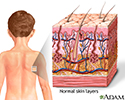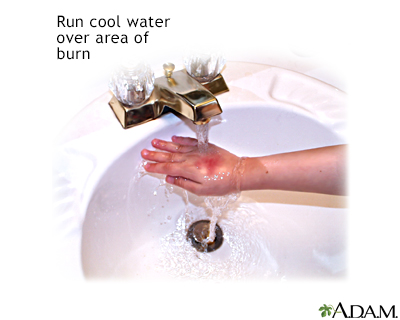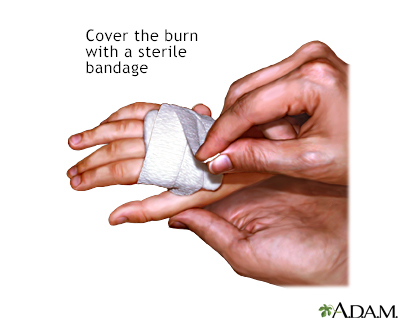Burns
First degree burn; Second degree burn; Third degree burnBurns commonly occur by direct or indirect contact with heat, electric current, radiation, or chemical agents. Burns can lead to cell death, which can require hospitalization and can be fatal.
Considerations
There are three levels of burns:
- First-degree burns affect only the outer layer of the skin. They cause pain, redness, and swelling.
- Second-degree burns affect both the outer and underlying layer of skin. They cause pain, redness, swelling, and blistering. They are also called partial thickness burns.
- Third-degree burns affect the deep layers of skin. They are also called full thickness burns. They cause white or blackened, burned skin. The skin may be numb.
Burns fall into two groups.
Minor burns are:
- First degree burns anywhere on the body
- Second degree burns less than 2 to 3 inches (in) or 5.08 to 7.62 centimeters (cm) wide
Major burns include:
- Third-degree burns
- Second-degree burns more than 2 to 3 in (5.08 to 7.62 cm) wide
- Second-degree burns on the hands, feet, face, groin, buttocks, or over a major joint
You can have more than one type of burn at a time.
Major burns need urgent medical care. This can help prevent scarring, disability, and deformity.
Burns on the face, hands, feet, and genitals can be particularly serious.
Children under age 4 and adults over age 60 have a higher chance of complications and death from severe burns because their skin tends to be thinner than in other age groups.
Causes
Causes of burns from most to least common are:
- Fire/flame
- Scalding from steam or hot liquids
- Touching hot objects
- Electrical burns
- Chemical burns
Burns can be the result of any of the following:
- House and industrial fires
- Car accidents
- Playing with matches
- Faulty space heaters, furnaces, or industrial equipment
- Unsafe use of firecrackers and other fireworks
- Kitchen accidents, such as a child grabbing a hot iron or touching the stove or oven
You can also burn your airways if you breathe in smoke, steam, superheated air, or chemical fumes in poorly ventilated areas.
Symptoms
Burn symptoms can include:
-
Blisters that are either intact (unbroken) or have ruptured and are leaking fluid.
Blisters
A vesicle is a small fluid-filled blister on the skin.
 ImageRead Article Now Book Mark Article
ImageRead Article Now Book Mark Article - Pain -- How much pain you have is unrelated to the level of burn. The most serious burns can be painless.
- Peeling skin.
-
Shock -- Watch for pale and clammy skin, weakness, blue lips and fingernails, and a decrease in alertness.
Shock
Shock is a life-threatening condition that occurs when the body is not getting enough blood flow. Lack of blood flow means the cells and organs do n...
 ImageRead Article Now Book Mark Article
ImageRead Article Now Book Mark Article - Swelling.
- Red, white, or charred skin.
You may have an airway burn if you have:
- Burns on the head, face, neck, eyebrows, or nose hairs
- Burned lips and mouth
- Coughing
-
Difficulty breathing
Difficulty breathing
Breathing difficulty may involve:Difficult breathing Uncomfortable breathingFeeling like you are not getting enough air
 ImageRead Article Now Book Mark Article
ImageRead Article Now Book Mark Article - Dark, black-stained mucus
- Voice changes
-
Wheezing
Wheezing
Wheezing is a high-pitched whistling sound during breathing. It occurs when air moves through narrowed breathing tubes in the lungs.
 ImageRead Article Now Book Mark Article
ImageRead Article Now Book Mark Article
First Aid
Before giving first aid, it is important to determine what type of burn the person has. If you are not sure, treat it as a major burn. Serious burns need medical care right away. Call 911 or the local emergency number.
MINOR BURNS
If the skin is unbroken:
- Run cool water over the area of the burn or soak it in a cool water bath (not ice water). Keep the area under water for at least 5 to 30 minutes. A clean, cold, wet towel will help reduce pain.
- Calm and reassure the person.
- After flushing or soaking the burn, cover it with a dry, sterile bandage or clean dressing.
- Protect the burn from pressure and friction.
- Over-the-counter ibuprofen or acetaminophen can help relieve pain and swelling. Do not give aspirin to children under 12.
- Once the skin has cooled, moisturizing lotion containing aloe and an antibiotic also can help.
Minor burns will often heal without further treatment. Make sure the person is up to date on their tetanus immunization.
MAJOR BURNS
If someone is on fire, tell the person to stop, drop, and roll. Then, follow these steps:
- Wrap the person in thick material; such as a wool or cotton coat, rug, or blanket. This helps put out the flames.
- Pour water on the person.
- Call 911 or the local emergency number.
- Make sure that the person is no longer touching any burning or smoking materials.
- Do not remove burned clothing that is stuck to the skin.
-
Make sure the person is breathing. If necessary, begin rescue breathing and CPR.
CPR
CPR stands for cardiopulmonary resuscitation. It is an emergency life-saving procedure that is done when someone's breathing or heartbeat has stoppe...
Read Article Now Book Mark Article - Cover the burned area with a dry sterile bandage (if available) or clean cloth. A sheet will do if the burned area is large. Do not apply any ointments. Avoid breaking burn blisters.
- If fingers or toes have been burned, separate them with dry, sterile, non-stick bandages.
- Raise the body part that is burned above the level of the heart.
- Protect the burn area from pressure and friction.
- If an electrical injury may have caused the burn, do not touch the victim directly. Use a non-metallic object to separate the person away from exposed wires before starting first aid.
You will also need to prevent shock. If the person does not have a head, neck, back, or leg injury, follow these steps:
- Lay the person flat
- Raise the feet about 12 in (30 cm)
- Cover the person with a coat or blanket
Continue to monitor the person's pulse, rate of breathing, and blood pressure until medical help arrives.
Do Not
Things that should not be done for burns include:
- Do not apply oil, butter, ice, medicines, cream, oil spray, or any household remedy to a severe burn.
- Do not breathe, blow, or cough on the burn.
- Do not disturb blistered or dead skin.
- Do not remove clothing that is stuck to the skin.
- Do not give the person anything by mouth if there is a severe burn.
- Do not place a severe burn in cold water. This can cause shock.
- Do not place a pillow under the person's head if there is an airway burn. This can close the airway.
When to Contact a Medical Professional
Call 911 or the local emergency number if:
- The burn is very large, about the size of your palm or larger.
- The burn is severe (third degree).
- You aren't sure how serious it is.
- The burn is caused by chemicals or electricity.
- The person shows signs of shock.
- The person breathed in smoke.
- Physical abuse is the known or suspected cause of the burn.
- There are other symptoms associated with the burn.
For minor burns, contact your health care provider if you still have pain after 48 hours.
Contact your provider right away if signs of infection develop. These signs include:
- Drainage or pus from the burned skin
- Fever
- Increased pain
- Red streaks spreading from the burn
-
Swollen lymph nodes
Swollen lymph nodes
Lymph nodes are present throughout your body. They are an important part of your immune system. Lymph nodes help your body recognize and fight germ...
 ImageRead Article Now Book Mark Article
ImageRead Article Now Book Mark Article
Also contact your provider right away if symptoms of dehydration occur with a burn:
- Decreased urination
-
Dizziness
Dizziness
Dizziness is a term that is often used to describe 2 different symptoms: lightheadedness and vertigo. Lightheadedness is a feeling that you might fai...
 ImageRead Article Now Book Mark Article
ImageRead Article Now Book Mark Article - Dry skin
-
Headache
Headache
A headache is pain or discomfort in the head, scalp, or neck. Serious causes of headaches are rare. Most people with headaches can feel much better...
 ImageRead Article Now Book Mark Article
ImageRead Article Now Book Mark Article - Lightheadedness
- Nausea (with or without vomiting)
- Thirst
Children, older people, and anyone with a weakened immune system (for example, from HIV) should be seen right away.
Your provider will perform a history and physical examination. Tests and procedures will be done as needed.
These may include:
- Airway and breathing support, including a face mask, tube through the mouth into the trachea, or breathing machine (ventilator) for serious burns or those involving the face or airway
- Blood and urine tests if shock or other complications are present
-
Chest x-ray for face or airway burns
Chest x-ray
A chest x-ray is an x-ray of the chest, lungs, heart, large arteries, ribs, and diaphragm.
 ImageRead Article Now Book Mark Article
ImageRead Article Now Book Mark Article -
Electrocardiogram (ECG), if shock or other complications are present
Electrocardiogram
An electrocardiogram (ECG) is a test that records the electrical activity of the heart.
 ImageRead Article Now Book Mark Article
ImageRead Article Now Book Mark Article -
Intravenous fluids (fluids through a vein), if shock or other complications are present
Intravenous
Intravenous means "within a vein. " Most often it refers to giving medicines or fluids through a needle or tube inserted into a vein. This allows th...
Read Article Now Book Mark Article - Medicines for pain relief and to prevent infection
- Ointments or creams applied to the burned areas
- Tetanus immunization, if not up to date
The outcome will depend on the type (degree), extent, and location of the burn. It also depends upon whether internal organs have been affected, and if other trauma has occurred. Burns can leave permanent scars. They can also be more sensitive to temperature and light than normal skin. Sensitive areas, such as the eyes, nose, or ears, may be badly injured and have lost normal function.
With airway burns, the person may have less breathing capacity and permanent lung damage. Severe burns that affect the joints may result in contractures, leaving the joint with decreased movement and a reduction in function.
Prevention
To help prevent burns:
- Install smoke alarms in your home. Check and change batteries regularly.
- Teach children about fire safety and the danger of matches and fireworks.
- Keep children from climbing on top of a stove or grabbing hot items such as irons and oven doors.
- Turn pot handles toward the back of the stove so that children can't grab them and they cannot accidentally be knocked over.
- Place fire extinguishers in key locations at home, work, and school.
- Remove electrical cords from floors and keep them out of reach.
- Know about and practice fire escape routes at home, work, and school.
- Set the water heater temperature at 120°F (48.8°C) or less.
References
Rybarczyk MM, Kivlehan SM. Thermal injuries. In: Walls RM, ed. Rosen's Emergency Medicine: Concepts and Clinical Practice. 10th ed. Philadelphia, PA: Elsevier; 2023:chap 54.
Voigt CD, Celis M, Voigt DW. Care of outpatient burns. In: Herndon DN, ed. Total Burn Care. 5th ed. Philadelphia, PA: Elsevier; 2018:chap 6.
Wolf SE. Burns. In: Townsend CM Jr, Beauchamp RD, Evers BM, Mattox KL, eds. Sabiston Textbook of Surgery. 21st ed. St Louis, MO: Elsevier; 2022:chap 20.
-
Burns - illustration
The depth of a burn determines its severity. First degree burns damage the outer layer of skin (epidermis) and cause pain, redness and swelling (erythema). Second degree burns damage the epidermis and the inner layer, the dermis, causing erythema and blistering. Damage from third degree burns extend into the hypodermis, causing destruction of the full thickness of skin with its nerve supply (numbness). Third degree burns leave scars and may cause loss of function and/or sensation.
Burns
illustration
-
Burn, blister - close-up - illustration
First degree burns produce only reddening of the skin. Second degree burns produce blistering, as seen here.
Burn, blister - close-up
illustration
-
Burn, thermal - close-up - illustration
Mild, or first degree burns cause only reddening of the epidermis (outer layer of the skin), as seen in this photograph. Second degree burns cause blistering and extend into the dermis (lower layer of skin). Third degree burns cause tissue death through the dermis and affect underlying tissues.
Burn, thermal - close-up
illustration
-
Airway burn - illustration
Burns to the airway can be caused by inhaling smoke, steam, superheated air, or toxic fumes, often in a poorly ventilated space. Airway burns can be very serious since the rapid swelling of burned tissue in the airway can quickly block the flow of air to the lungs.
Airway burn
illustration
-
Skin - illustration
The skin is the largest organ of the body. The skin and its derivatives (hair, nails, sweat and oil glands) make up the integumentary system. One of the main functions of the skin is protection. It protects the body from external factors such as bacteria, chemicals, and temperature.
Skin
illustration
-
First degree burn - illustration
First degree burns affect the outer layer of the skin, causing pain, redness, and swelling.
First degree burn
illustration
-
Second degree burn - illustration
Second-degree burns affect both the outer and underlying layer of the skin, causing pain, redness, swelling, and blistering.
Second degree burn
illustration
-
Third degree burn - illustration
Third-degree burns extend into deeper tissues, causing brown or blackened skin that may be numb.
Third degree burn
illustration
-
Minor burn treatment - run under cool water
Presentation
-
Burns - illustration
The depth of a burn determines its severity. First degree burns damage the outer layer of skin (epidermis) and cause pain, redness and swelling (erythema). Second degree burns damage the epidermis and the inner layer, the dermis, causing erythema and blistering. Damage from third degree burns extend into the hypodermis, causing destruction of the full thickness of skin with its nerve supply (numbness). Third degree burns leave scars and may cause loss of function and/or sensation.
Burns
illustration
-
Burn, blister - close-up - illustration
First degree burns produce only reddening of the skin. Second degree burns produce blistering, as seen here.
Burn, blister - close-up
illustration
-
Burn, thermal - close-up - illustration
Mild, or first degree burns cause only reddening of the epidermis (outer layer of the skin), as seen in this photograph. Second degree burns cause blistering and extend into the dermis (lower layer of skin). Third degree burns cause tissue death through the dermis and affect underlying tissues.
Burn, thermal - close-up
illustration
-
Airway burn - illustration
Burns to the airway can be caused by inhaling smoke, steam, superheated air, or toxic fumes, often in a poorly ventilated space. Airway burns can be very serious since the rapid swelling of burned tissue in the airway can quickly block the flow of air to the lungs.
Airway burn
illustration
-
Skin - illustration
The skin is the largest organ of the body. The skin and its derivatives (hair, nails, sweat and oil glands) make up the integumentary system. One of the main functions of the skin is protection. It protects the body from external factors such as bacteria, chemicals, and temperature.
Skin
illustration
-
First degree burn - illustration
First degree burns affect the outer layer of the skin, causing pain, redness, and swelling.
First degree burn
illustration
-
Second degree burn - illustration
Second-degree burns affect both the outer and underlying layer of the skin, causing pain, redness, swelling, and blistering.
Second degree burn
illustration
-
Third degree burn - illustration
Third-degree burns extend into deeper tissues, causing brown or blackened skin that may be numb.
Third degree burn
illustration
-
Minor burn treatment - run under cool water
Presentation
Review Date: 5/28/2024
Reviewed By: Ramin Fathi, MD, FAAD, Director, Phoenix Surgical Dermatology Group, Phoenix, AZ. Also reviewed by David C. Dugdale, MD, Medical Director, Brenda Conaway, Editorial Director, and the A.D.A.M. Editorial team.














